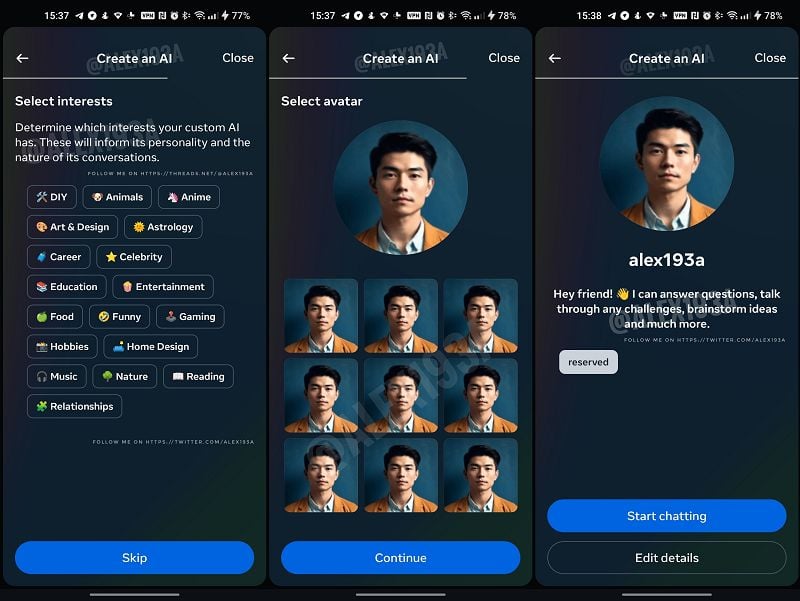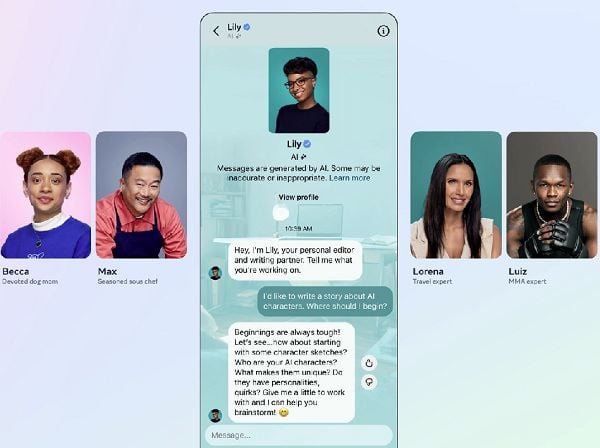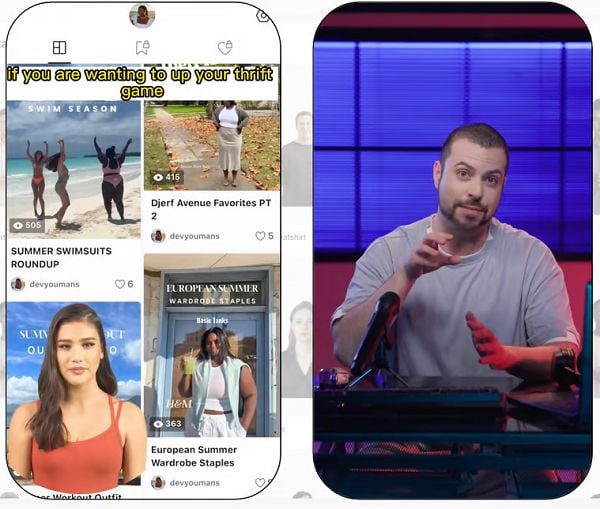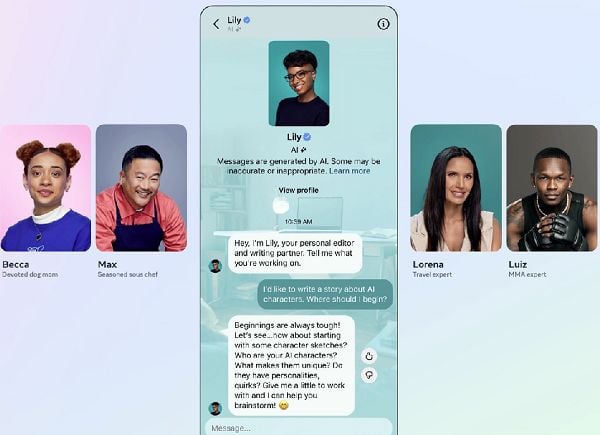While social platforms are super keen to tap into the generative AI trend, I’m not sure that they’ve worked out a good way to truly integrate AI tools in order to complement their core use case just yet.
Sure, there are some generative AI elements that have sparked trending interest, like image generation tools, and even certain chatbots, like Snapchat’s ‘My AI’. But for the most part, the AI tools that we’re getting actually detract from the central mission of social apps, in that they reduce the actual social interaction element.
Though that is, of course, in a human-to-human sense, and maybe, that’s not actually where things are headed.
Are we moving to a new stage of digital interaction, where humans don’t necessarily have to be involved in conversations? Will chatbots eventually enable all new forms of social engagement, which reduce the need for real people?
And ultimately, is that a good thing, and will they still qualify as “social” media platforms if the social part isn’t actually social engagement as we know it?
This week, Meta CEO Mark Zuckerberg outlined his plans for the next stage of generative AI connection within social apps, which Meta is now working towards by building a massive stockpile of hardware to power its advanced systematic processing in its apps.
One of the key coming use cases identified by Zuckerberg (in his interview with The Verge) was this:
“[Zuckeberg] sees a future in which virtual worlds are generated by AI and filled with AI characters that accompany real people. He says a new platform is coming this year to let anyone create their own AI characters and distribute them across Meta’s social apps. Perhaps, he suggests, these AIs will even be able to post their own content to the feeds of Facebook, Instagram, and Threads.”
We’ve actually already seen the first hints of this, with app researcher Alessandro Paluzzi uncovering this AI character creation process in Instagram’s back-end code back in October.

With this AI character creation process, you’d be able to choose your character’s gender and conversation style, as well as their interests, essentially building an imaginary friend for yourself who’ll always be there, waiting inside Meta’s messaging apps.
Which is interesting, for sure, but what’s really the end result? Is this more social, in engaging with something, even if it’s not a real person? Is it healthy to be creating an AI persona to engage with, and developing an artificial relationship?
Also, do users actually want this?
That’s a key question in Meta’s AI development plans. Last year, Meta also unveiled its somewhat similar AI chatbots, which are infused with the personalities of various celebrities.

Meta seemed to think that this was a major announcement, and a major shift towards more engaging, valuable AI options within social apps. But when the novelty of chatting with a bot that kind of sounds like Kendall Jenner has worn off (which is pretty quick), who really cares about conversing with non-humans in social apps?
It also runs counter to one of main selling points of social platforms in the past, in that users can actually send a note to a celebrity in these apps, and potentially, maybe get a response. Social media has acted as a key connector, and an equalizer in this respect, in that everybody uses the same platforms, and we can all engage, with anyone, in real time.
Celebrity-like bots are just a lesser version of this, so why Meta thinks this would be a valuable engagement point, so much so that it’s now looking to enable users to create their own bots as well, is unclear.
Except that they really don’t have a valuable use case for the current generative AI tools, with text-based chatbots, in particular, serving no real purpose in social streams.
There is some case to be made that using generative AI to come up with better posts could be of value, and both LinkedIn and X are experimenting with exactly that. But the same issue arises, in that the more we start employing robots for human interaction, the more those interactions become less human, and thus, less valuable for real human users.
Case in point, there are already many examples of AI chatbot originated responses to posts on X, which, in theory, creators could also then respond to with similar generated replies.
How long until these conversations are just bots engaging with other bots, which will then dilute the value of social platforms for anything other than tracking the latest news stories, essentially eliminating the “social” aspect outright? In this sense, they’re moving more towards broadcast media, with the traditional connective value declining, which is already happening, but looks set to be accelerated by broader bot infusion.
Meta, intentionally or not, is leaning into this, as it searches for an in-stream use case for its advancing AI, while TikTok is also now working on a new bot platform that would enable you to create AI-simulated human-like characters for varying purpose.

As reported by Lindsey Gamble:
“TikTok is beta-testing Digital Avatars, a new creative product with select advertisers. Powered by AI, these avatars serve as narrators with physical movements, facial expressions, and voiceovers. Advertisers can choose from over 100 avatars varying in appearance, accents, and languages to be used for narrating product demos and how-to ads.”
This has already become a cottage industry in China, where TikTok’s parent company ByteDance has facilitated the use of these CGI characters to help businesses sell products on live streams.
@88.tom ???? The future is here. Deepfaked influencers are taking over China’s livestream shopping scene! With just 1 minute of video, brands can now create an AI version of themselves to sell goods 24/7. Disclaimer: The AI streamers in the video are trained on real people using AI to deepfake the face and to generate voice/script. AI avatars cannot be generated 100% by text alone at this time. So if you’re a livestream influencer, you still have time. ???? #fyp #foryoupage #AI #deepfake ♬ original sound – 88.tom
As noted in this clip “virtual humans” can be employed to sell items on live streams 24/7, at far lower costs than hiring real people for the same job. The bots are trained on human movement, and at a glance, they look interesting enough.
Seemingly, TikTok is now pushing to implement the same in Western markets, as part of its continued push to make live-stream shopping a thing, even though most Western users have shown little interest.
But it’s another potential step towards bots completely taking over social media apps, and subsequently reducing human interaction entirely.
Will that make us more likely to keep using social apps, or will it push more people to meet up in real life, in order to feel actual, real feelings and response?
There is also something to be said about the mental health benefits, potentially, of AI characters, who are always there for you, and will listen to whatever you have to say, without judgment.
Is that better for society?
Of course, we don’t know, but the bottom line is that there is no killer use case for generative AI within social apps as yet.
The integration of chatbots is interesting in some respects, and visual creation tools also hold promise in varying use cases.
But it feels like social apps are still searching for where these tools fit, and how they align with their core use case.
Maybe, in a future VR world, having the capacity to generate entirely new experiences by speaking them into existence will be valuable, and will change the game on AI understanding and capacity. But I’m not sure the current state of social media apps really needs AI, as much as the platforms want to make it so.



